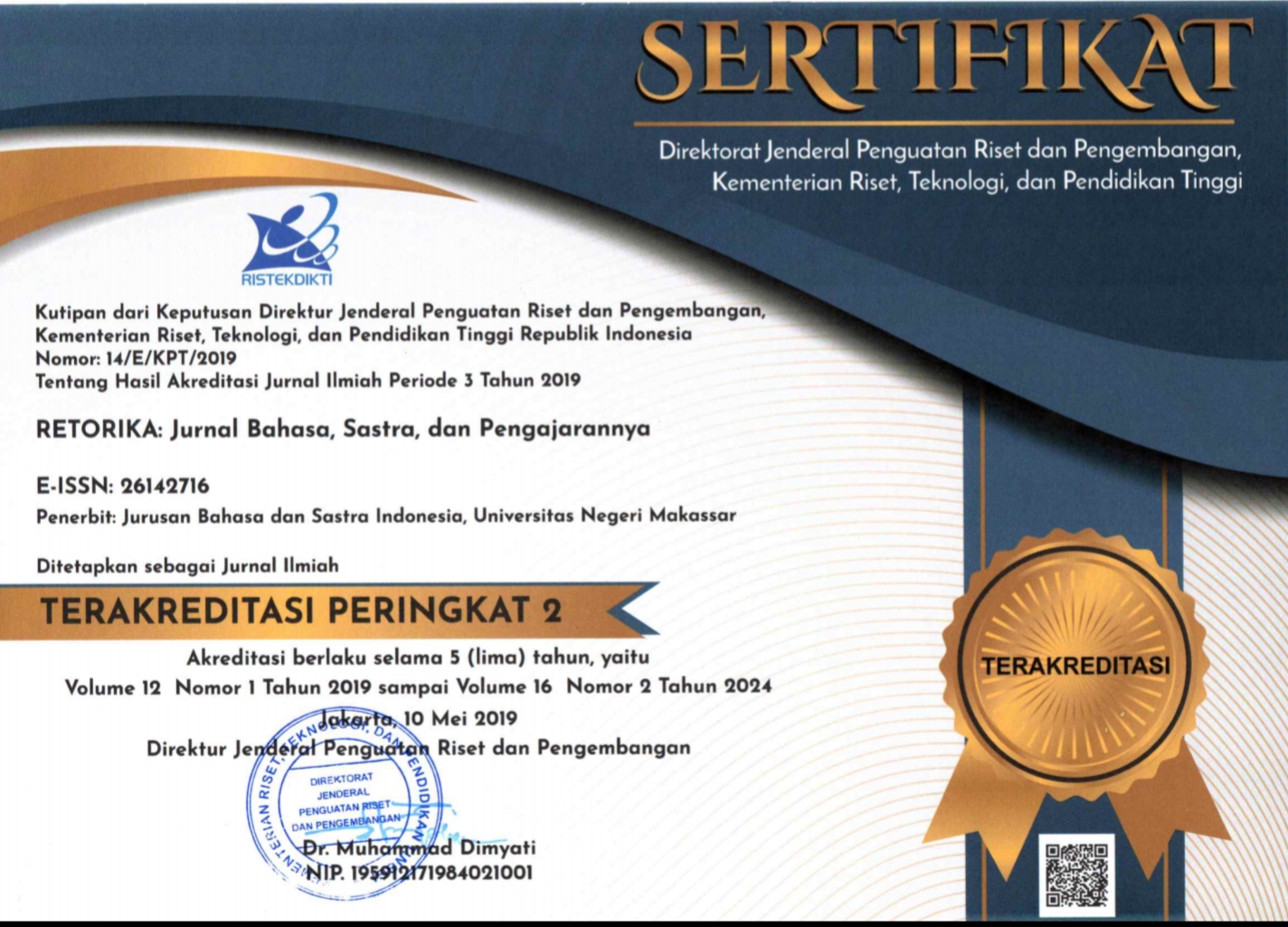VOICE SYSTEMS IN MANGGARAI: HOW SEMANTIC ROLES BEHAVE IN THE CLAUSES
(1) Linguistics, Department of Language and Literature, Faculty of Cultural Sciences, Gadjah Mada University
(*) Corresponding Author
DOI: https://doi.org/10.26858/retorika.v16i2.43382
Abstract
Keywords
Full Text:
PDFReferences
Aritonang, B. (2018). Klitik Klausa Pasif Bahasa Manggarai Dialek Barat. Buletin Al-Turas Vol. XXIV No.1, pp. 51-67. https://doi.org/10.15408/bat.v24i1.7191.
Arka, I. W., & Kosmas, J. (2005). Passive Without Passive Morphology? Evidence from Manggarai. Pacific Linguistics.https://doi.org/10.13140/RG.2.1.3517.4007 .
Arka, I. W., & Ross, M. (2005). The Many Faces of Austronesian Voice Systems: Some New Empirical Studies. Pacific Linguistics. https://doi.org/10.1353/ol.2007.0009.
Arka, W. (2008). Voice and Being Core: Evidence from (Eastern) Indonesian Languages. In P. K. Austin & S. Musgrave (Eds.), Voice and Grammatical Relations in Austronesian Languages. CSLI Publications (pp. 183-227). http://hdl.handle.net/1885/41057.
Arka, I. W., & Wouk, F. (2014). Voice-Related Constructions in the Austronesian languages of Flores. Asia-Pacific Linguistics. http://hdl.handle.net/1885/29328.
Begus, G. (2016). The Origins of the Voice/Focus System in Austronesian. 42nd Annual Meeting, Berkeley Linguistic Society. https://scholar.harvard.edu/files/begus/files/begus_the_origins_of_voice_focus_system_in_austronesian_ws.pdf .
Bellwood, P. (1985). A Hypothesis for Austronesian Origin. Asian Perspectives, Vol. 26, No. 1, pp. 107-117. University of Hawai'i Press.
Bellwood, P. (2006). Austronesian Prehistory in Southeast Asia: Homeland, Expansion and Transformation. In P. Bellwood, J. J. Fox, & D. Tryon (Ed.), The Austronesians: Historical and Comparative Perspectives (pp. 103-118). ANU Press.
Blust, R. (1993). Austronesian Sibling Terms and Culture History. Bijdragen tot de Taal-, Land- en Volkenkunde, Vol 149 (1), pp. 22-76.
Blust, R. (2002). Notes on the JHistory of 'Focus' in Austronesian Languages. In F. Wouk and M. Ross (Eds.), The history and typology of western Austronesian voice systems (pp. 63-78). Canberra: Pacific Unguistics. https://doi.org/10.15144/PL-518.63 .
Blust, R. (2008). Is There a Bima-Sumba Subgroup? Oceanic Linguistics 47(1), pp. 45-113. https://doi.org/10.1353/ol.0.0006
Blust, R. (2013). The Austronesian Language (Revised Version). Asia-Pacific Linguistics. http://hdl.handle.net/1885/10191.
Chen, V., & McDonnell, B. (2019). Western Austronesian Voice. Annual Review of Linguistics Vol. 5, pp. 173–95. https://doi.org/10.1146/annurev-linguistics-011718-011731 .
Donohue, M. (2004). Typology and Linguistic Areas. Oceanic Linguistics Vol. 43, (1), pp. 221-239. https://doi/org/10.1353/ol.2004.0008.
Donohue, M. (2004). A Voice Opposition Without Voice Morphology. Proceedings of AFLA 11, pp. 73-88. ZASPiL (ZAS Papers in Linguistics). https://doi.org/10.21248/zaspil.34.2004.204.
Donohue, M. (2007). Malay as a Mirror of Austronesian: Voice development and voice variation. Lingua Vol. 118, pp. 1470–1499. https://doi.org/10.1016/j.lingua.2007.08.007.
Elias, A. (2018). Lio and the Central Flores languages. [Master's thesis, Universiteit Leiden].
Elias, A. (2020). Are the Central Flores Languages Really Typologically Unusual? In D. Gil and A. Schapper (Eds.), Austronesian Undressed: How and why languages become isolating. Typological Studies in Language (pp. 287-338). John Benjamin Publishing Company. https://doi.org/10.1075/tsl.129.06eli.
Erb, M. (1997). Contested Time and Place: Constructions of History in Todo, Manggarai (Western Flores, Indonesia). Journal of Southeast Asian Studies.https://doi.org/10.1017/S0022463400015174.
Grimes, C. E. (1997). A Guide to the people and languages of Nusa Tenggara. Kupang; Prepha Wacana Press.
Hagul, A. (1993). Tata Bahasa Daerah Manggarai NTT. Flores: Lembaga Kebudayaan Manggarai
Keenan, E. L. (1976). Remarkable subjects in Malagasy. In C.N. Li: 247-301. https://linguistics.ucla.edu/people/keenan/Papers/Keenan1976.pdf.
Keenan, E. L., & Dryer, M. S. (2006). Passive in the World’s Languages. Cambridge University Press. https://doi.org/10.1017/CBO9780511619427.006
Klamer, M. (2002). Typical Features of Austronesian Languages in Central/Eastern Indonesia. Oceanic Linguistics. https://doi.org/10.1353/ol.2002.0007.
Klamer, M., & Ewing, M. (2010). The languages of East Nusantara: An introduction. In K. M. Ewing Michael (Ed.), Typological and Areal Analyses: Contributions from East Nusantara (pp. 1-24). Canberra: Pacific Linguistics. https://hdl.handle.net/1887/18306.
Kosmas, J. (2015). Konstruksi Pasif Bahasa Manggarai: Sebuah Analisis Leksikal Fungsional. RETORIKA: Jurnal Ilmu Bahasa, Vol. 1, No. 1 April 2015, 108-122. https://doi.org/10.22225/jr.1.1.16.108-122
LaPolla, R. J. (2006). On Grammatical Relations as Constraints on Referent Identification. Voice and Grammatical Relation: In Honor of Masayoshi Shibatani. Typological Studies in Language. https://doi.org/10.1075/tsl.65.09lap
Mangga, S. (2013). Bentuk Pasif dalam Bahasa Manggarai. Graduate Thesis, Gadjah Mada University.
Mangga, S. (2015). Konstruksi Pasif dalam Bahasa Manggarai: Pasif Tanpa Pemarkah Verba Pasif. Ranah Volume 4. https://doi.org/10.26499/rnh.v4i2.29 .
Mangga, S. (2016). Klitika dalam Klausa Pasif Bahasa Manggarai. Linguistik Indonesia, Vol. 34 (1), pp. 57-66. https://doi.org/10.26499/li.v34i1.41.
Nagaya, N. (2013). Voice and gGammatical Relations in Lamaholot of eastern Indonesia. Proceedings of the Workshop on Indonesian-type Voice System.
Sajarwa. (2021). Metode Penelitian Bahasa. FIB UGM PRESS,
Shibatani, M. (1988). Passive and Voice. John Benjamins Publishing Company. https://doi.org/10.1075/tsl.16.
Sudaryanto. (1993). Metode dan Aneka Teknik Analisis Bahasa: Pengantar Penelitian Wahana Kebudayaan secara Linguistis. Yogyakprepa: Duta Wacana University Press.
Trudgill, P. (2004). Linguistic and Social Typology: The Austronesian Migrations and Phoneme Inventories. Linguistic Typology, Vol. 8: 305–320. https://doi.org/10.1515/lity.2004.8.3.305.
Verhaar, J. W. M. (2006). Asas-Asas Linguistik Umum. Yogyakarta: Gadjah Mada University Press.
Verheijen, J.A.J. (1977). The lack of formative IN Affixes in The Manggarai Language. NUSA 5:35-37. http://sealang.net/archives/nusa/pdf/nusa-v5-p35-37.pdf.
Article Metrics
Abstract view : 151 times | PDF view : 38 timesRefbacks
- There are currently no refbacks.
Copyright (c) 2023 Salahuddin Salahuddin

This work is licensed under a Creative Commons Attribution-NonCommercial 4.0 International License.
Published by:
Department of Indonesian Language, Faculty of Languages and Literature, Universitas Negeri Makassar in cooperate with Asosiasi Dosen Bahasa dan Sastra Indonesia (ADOBSI) and Ikatan Program Studi Pendidikan Bahasa dan Sastra Indonesia (IKAPROBSI).
Address: Department of Indonesian Language Office, DG Building Second Floor, UNM Parangtambung, Daeng Tata Raya Street, Makassar, South Sulawesi, Indonesia
 Email: [email protected]
Email: [email protected]

RETORIKA: Jurnal Bahasa, Sastra,dan Pengajarannya is licensed under a Creative Commons Attribution-NonCommercial 4.0 International License.
















